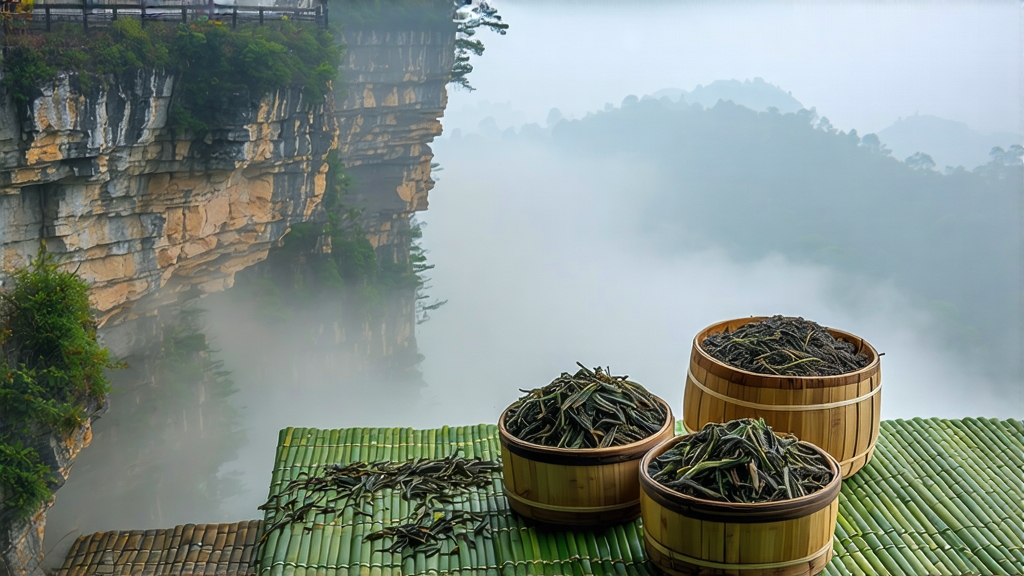
Ask most tea lovers to name China’s oldest black tea and they will, almost without fail, murmur “Lapsang Souchong.” Yet behind the melodious name lies a saga of military urgency, Ming-dynasty ingenuity, and a flavor so audacious that it once sailed around Cape Horn to light the samovars of St. Petersburg and the breakfast tables of Victorian London. This is the story of how a tiny village in the Wuyi Mountains of Fujian Province gave the world its first fully oxidized leaf—and why, four centuries later, connoisseurs still argue whether the best cup tastes of pine, plum, or peated single-malt whisky.
-
A Leaf Born from Chaos
In the late Ming, around 1604, an imperial army unit passed through Tongmu Village on its way to quell coastal pirates. The soldiers commandeered the tea sheds, forcing freshly picked green leaves to wait overnight. By morning the greens had turned a dull copper; oxidation had begun. To “save” the crop, quick-thinking farmers spread the leaves over pine fires, drying them rapidly and imparting a resinous perfume. The Dutch traders who received the shipment at Xiamen port christened it “bohea,” a corruption of “Wuyi,” and Europe’s love affair with red tea—what the West later called black tea—had begun. -
Tongmu Terroir: Where Minerals Meet Mist
Tongmu sits in a granite gorge at 27° N latitude, 1,200 m above sea level. Day-night temperature swings of 15 °C slow leaf growth, concentrating amino acids. The soil is a loose, acidic laterite laced with quartz and manganese; locals swear the manganese lends the tea’s signature sweetness. Ninety percent of the year the gorge is wrapped in fog, filtering sunlight into a soft, diffused glow that encourages the formation of linalool and geraniol—aromatic compounds later amplified by smoke. -
Three Styles, One Genealogy
a) Traditional Pine-Smoked Lapsang Souchong
The original “Zheng Shan Xiao Zhong” is still withered over local Masson pine embers in long, brick-lined channels. After rolling, the leaves are placed on bamboo trays above smouldering pinewood logs whose resin content averages 28 %—double that of common pine. A final high-temperature bake locks in a tarry bouquet reminiscent of lapsang whisky and dried longan.
b) Unsmoked “Wuyi Black”
In 2005 a Tongmu master named Jiang Yuanxun experimented with drying the leaf in electrically heated ovens, aiming to satisfy modern Chinese palates that equate smoke with pollution. The result is a sleek, cocoa-rich liquor with hints of honeyed peach; it now commands higher prices in Shanghai than its smoked ancestor.
c) Jin Jun Mei
A bud-only luxury grade created in 2006, plucked at dawn between Qingming and Guyu from 1,600-year-old wild tea trees. Processed like unsmoked Lapsang but withering takes place in bamboo drums rotated by hand every 30 minutes. The cup is a shimmering amber-gold, tasting of caramelised persimmon and alpine rose.
- Crafting the Smoke: An Hour-by-Hour Diary
Day 1, 4 a.m. Pickers climb the gorge carrying rattan baskets lined with fresh banana leaves to prevent bruising. Only the middle three leaves are taken—too young and the smoke overwhelms; too old and the maltiness turns leathery.
8 a.m. Withering: 8 cm layers of leaf are laid on bamboo racks inside the qinglou, a three-storey wooden house whose top floor is latticed to admit pine-scented draughts. Here the leaf loses 62 % of its moisture in four hours, twice the rate of Keemun, kick-starting enzymatic oxidation.
Noon Rolling: A 55-year-old craftsman named Wu Shunyou works a cast-iron roller at 70 r.p.m.—fast enough to rupture cells yet slow enough to keep buds intact. The aroma shifts from cut grass to bruised apple.
3 p.m. Oxidation: Leaves are heaped 30 cm deep in pine-wood troughs lined with wet cloths; temperature held at 26 °C, humidity